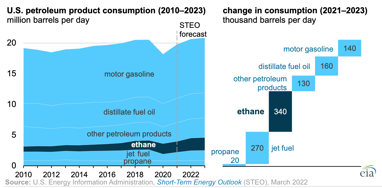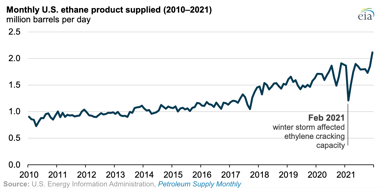Ethane to outpace growth in all other U.S. petroleum product consumption through 2023

(EIA)—Consumption of ethane has grown every year since 2010 in the U.S., and more ethane is now consumed in the country than either jet fuel or propane. Consumption of ethane, which the EIA estimates using product supplied, grew by 50,000 bpd in 2021, according to data from its March 2022 Petroleum Supply Monthly. The EIA forecasts that by 2023, U.S. consumption of ethane will grow by another 340,000 bpd.
Annual U.S. ethane consumption has increased in every year since 2010 because demand for ethane as a petrochemical feedstock has grown. Ethane mainly serves as a petrochemical feedstock to produce ethylene, which is used to make plastics and resins.
Domestic ethane consumption over the past two years has increased due to increased ethylene cracking capacity. In contrast, consumption of most other petroleum products has decreased these past two years as a result of less travel during the COVID-19 pandemic.
U.S. ethane consumption grew in 2021 despite the mid-February winter storm on the U.S. Gulf Coast, which took more than one-third of U.S. ethylene cracking capacity offline. Because about 90% of U.S. ethane consumption is concentrated along the Gulf Coast, storm disruptions reduced ethane consumption by 655,000 bpd in February 2021. Despite this drop, the additional capacity from two new ethylene crackers during the second half of 2021 contributed to an overall increase in ethane consumption in 2021.

The EIA expects U.S. ethane consumption to average 2.1 MMbpd in both 2022 and 2023 because another ethylene cracker was recently completed in Monaca, Pennsylvania, which will add an estimated 96,000 bpd of ethane feedstock capacity, and existing ethylene crackers should operate at higher utilization rates.
In the U.S., cracking ethane has a higher profit margin than cracking naphtha to produce ethylene, a key component needed to produce many resins and plastics. Ethane’s relatively low cost and high ethylene yield have spurred growth in ethane use as an ethylene feedstock in the U.S. and, increasingly, around the world. Although naphtha cracking can yield valuable co-products such as propylene, butadiene, benzene, toluene and xylene, demand for ethylene has been outpacing demand for those co-products of naphtha cracking.
Principal contributor: Josh Eiermann






Comments